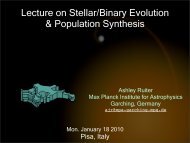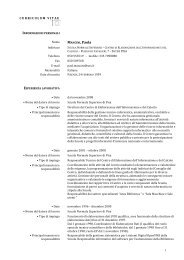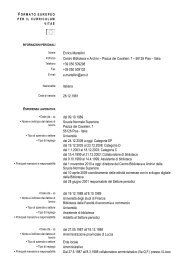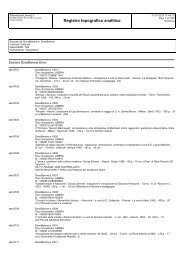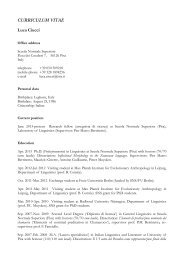Metrics of curves in shape optimization and analysis - Andrea Carlo ...
Metrics of curves in shape optimization and analysis - Andrea Carlo ...
Metrics of curves in shape optimization and analysis - Andrea Carlo ...
Create successful ePaper yourself
Turn your PDF publications into a flip-book with our unique Google optimized e-Paper software.
It is <strong>in</strong>terest<strong>in</strong>g to notice that the H 1 <strong>and</strong> ˜H 1 gradient flows are well-posedfor both ascent <strong>and</strong> descent while the H 0 gradient flow is only well-posed fordescent. This is related to the fact that the H 0 gradient descent flow smoothsthe curve, whereas the ˜H 1 gradient descent (or ascent) has neither a beneficialnor a detrimental effect on the regularity <strong>of</strong> the curve.10.7 Regularization <strong>of</strong> energy vs regularization <strong>of</strong> flow/metricImag<strong>in</strong>e an energy E m<strong>in</strong>imized on <strong>curves</strong> (numerically sampled to p po<strong>in</strong>ts).Suppose it is not satisfactory <strong>in</strong> applications (it may be ill posed, or not robustto noise). We have two solutions available.• Add a regularization term R(c) <strong>and</strong> m<strong>in</strong>imize E(c)+εR(c) by H 0 gradientdescent. The numerical complexity <strong>of</strong> comput<strong>in</strong>g ∇ H 0R is <strong>of</strong> order O(p).• M<strong>in</strong>imize E(c) by ˜H 1 gradient descent. The numerical complexity <strong>of</strong>comput<strong>in</strong>g ∇˜H1E us<strong>in</strong>g the equations <strong>in</strong> Prop. 10.10 is <strong>of</strong> order O(p).The numerical complexity <strong>of</strong> the two approaches is similar; but <strong>in</strong> the secondcase we are m<strong>in</strong>imiz<strong>in</strong>g the orig<strong>in</strong>al energy. This can br<strong>in</strong>g evident benefits, asshown <strong>in</strong> the follow<strong>in</strong>g example (orig<strong>in</strong>ally presented <strong>in</strong> the 2006 IMA conferenceon <strong>shape</strong> spaces).Example 10.33 We consider a region-based segmentation <strong>of</strong> a synthetic noisyimage, where the energy is the Chan-Vese energyE(c) =∫(I − u) 2 dA +c <strong>in</strong>∫(I − v) 2 dAc outplus the regularization terms α len(c) for H 0 flows.When flow<strong>in</strong>g accord<strong>in</strong>g to −∇ H 0E + ακN <strong>and</strong> a small value <strong>of</strong> α > 0, weobta<strong>in</strong> the follow<strong>in</strong>g evolution <strong>of</strong> the curve, where the curve gets trapped <strong>in</strong> alocal m<strong>in</strong>ima due to noise.For a larger value <strong>of</strong> α, the regularization term forces the curve away fromthe square <strong>shape</strong>.When evolv<strong>in</strong>g us<strong>in</strong>g −∇˜H1E, the curve captures the correct <strong>shape</strong> on coarsescale, <strong>and</strong> then segments the noisy boundary <strong>of</strong> the square further.83


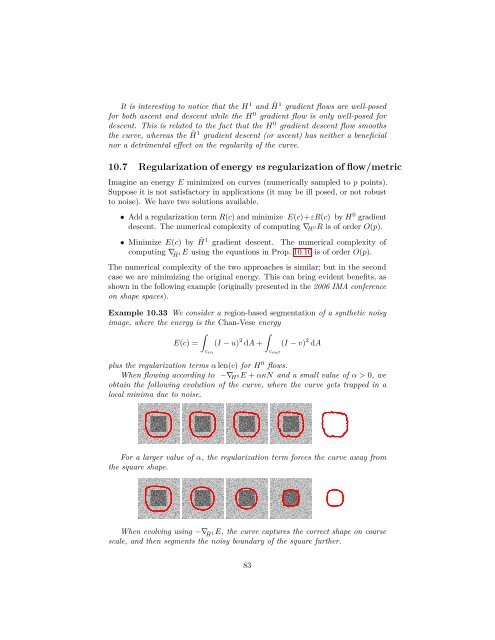

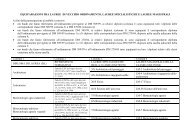
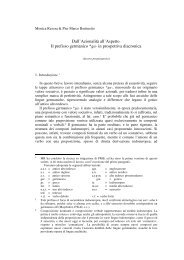
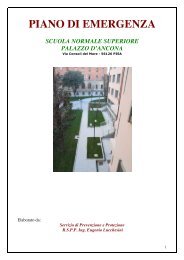
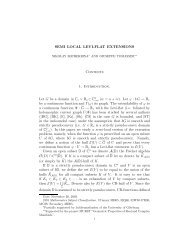
![4. Ghost [Å] vowels in French - Laboratorio di Linguistica](https://img.yumpu.com/49999334/1/184x260/4-ghost-a-vowels-in-french-laboratorio-di-linguistica.jpg?quality=85)


